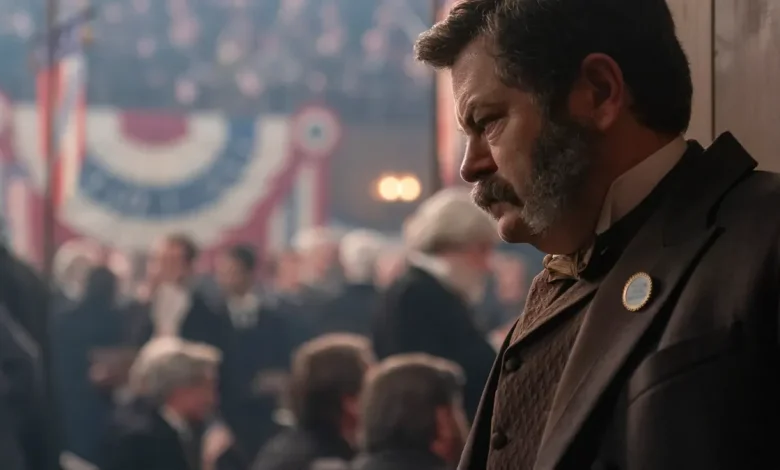What’s real and what’s not in historical assassination series ‘Death by Lightning’

Michael Shannon talks gun violence and Netflix’s ‘Death by Lightning’
Actors Michael Shannon and Matthew Macfadyen chat with USA TODAY’s Ralphie Aversa about the new Netflix historical drama “Death by Lightning.”
Assassins lying in wait, political corruption, drunken vice presidential nominees: Is Netflix’s “Death by Lightning” a wild invention of Hollywood, or was 19th century political history actually this crazy?
“The answer is yes,” says Mike Makowsky, creator of the historical Netflix drama (now streaming) about the assassination of President James Garfield (Michael Shannon) in 1881. “These situations are insane and so unfathomable by today’s standards (and) how we understand our politics.”
The superb limited series, which also stars Matthew MacFadyen as assassin Charles Guiteau and Nick Offerman as Garfield’s vice president Chester A. Arthur, is based on historian Candice Millard’s 2011 book “Destiny of the Republic.” The book and the series both bring to light a period from American history not often mentioned or emphasized in our textbooks or modern culture. But it is a fascinating and oftentimes absurd story nonetheless. And Makowsky and his fellow writers did not need to add much to make it worthy of four episodes of exciting and shocking television.
USA TODAY spoke with Makowsky about what’s real and what’s not in the series. His main goal, he said, was to get viewers more interested in American history, even if the show couldn’t tell the entire story. “I definitely was not able to include everything in four hours,” he says. “The hope is that people are able to engage with history in that way, and that they’re curious to learn more.” After watching the series, you likely had the same questions we did.
Was James Garfield really that much of a stand-up guy? Did he have his own indiscretions and affairs?
Although the show merely alludes to problems in the past in Garfield’s marriage to Lucretia Garfield (Betty Gilpin), there is historical evidence to suggests he had a relationship with Kate Sprague, the paramore of Garfield’s political rival Roscoe Conkling (Shea Whigham). Sprague is played by Tuppence Middleton.
“At a minimum, she and Garfield at one point, when Garfield was more rooted in the Washington scene, the two of them enjoyed a very close friendship,” Makowsky says. He added that the show decided not to include that because it was so far in Garfield’s past and they didn’t want to bog down the show with flashbacks. However, “Garfield does say to his wife in the show, ‘you of all people know that or the one person who essentially knows that that I’m the furthest thing from a great man.'”
Could people really just freely walk up to Senators and Presidents in the 1880s? Could Charles Guiteau really accost those people in public and private spaces?
“Presidents didn’t have security detail” in the 19th century, says Makowsky. “Presidents at the time would have office hours, essentially, everyday in the White House. Anybody could show up have an audience with their president. Just a little nuts.”
“It was incomprehensible to men of Garfield’s era that anyone would ever want to go out and shoot a president, even though, of course, 15 years prior (President Abraham) Lincoln had been killed. But he was killed days after the Civil War. And it was a very, very, very politically charged moment.”
“Garfield just saw himself as a civil servant. He wasn’t flashy,” Makowsky adds. In fact, the show takes its title from a direct Garfield quote about the unlikelihood of political assassination: “Assassination could be no more guarded against than death by lightning.” Garfield believed he couldn’t be protected from random political violence by a security detail or anything else.
What about the Secret Service?
The Secret Service didn’t have responsibility for full time protection of the president until 1902, after the 1901 assassination of President William McKinley.
Was Guiteau’s brain really kept by the government?
Yes, and “they cut out his brain out of his head as a medical specimen,” Makowsky says. “I don’t think that doctors in the time were equipped to look through a brain and understand (the person). So they sort of just saved it for, for the future and then forgot about it for a number of years.”
Historians agree that Guiteau was likely mentally ill, but no official diagnosis has drawn consensus. But as part of his research for the show, Makowsky got a chance to see the brain in person.
“I got to see the brain,” he says. “I had to actually get special government permission because it’s at a, bizarrely enough, a military base in Maryland. The government doesn’t like to as a rule, like showcase of assassin artifacts.”
Did Guiteau and Chester A. Arthur really have a drunken night out at a ladies’ boxing match?
No. Makowksy admits that is wholly the invention of himself and writers, but, “when you have Matthew McFadyen and Nick Offerman, I just couldn’t resist.”
“Arthur had a passing familiarity with Guiteau,” he says. “Guiteau was around a lot. He would show up at the campaign headquarters. He was constantly trying to impose himself on (political figures). But there’s no real evidence to suggest that the two of them spent the night out.”
Was Garfield really killed by an infection caused by his doctors?
Yes, that bit of historical trivia is part of Garfield’s abbreviated legacy. The show portrays Garfield’s doctors rummaging around in his open wound and using a metal detector in a desperate search to remove the bullet. After a prolonged convalescence, we see him die of an infection beside his wife Crete (Betty Gilpin).
Garfield was shot before germ theory was widely accepted by doctors, who did not wash their hands or sanitize medical tools. Whether it came directly from his doctors’ dirty hands and equipment is hard to prove with 100% certainty, as the entire world was dirty back then, too. According to a PBS article about the assassination, “This assault and its aftercare probably led to an overwhelming infection known as sepsis … the doctors’ dirty hands and fingers are often blamed as the vehicle that imported the infection into the body. But given that Garfield was a surgical and gunshot-wound patient in the germ-ridden, dirty Gilded Age, a period when many doctors still laughed at germ theory, there might have been many other sources of infection as well.”





